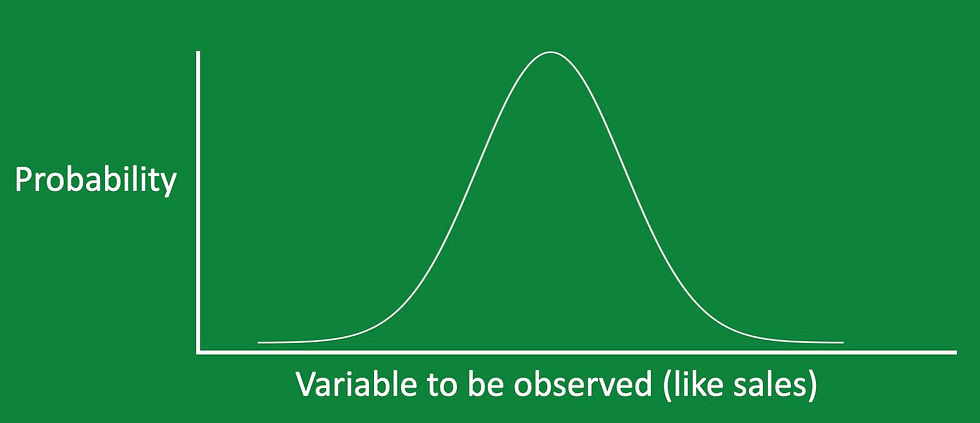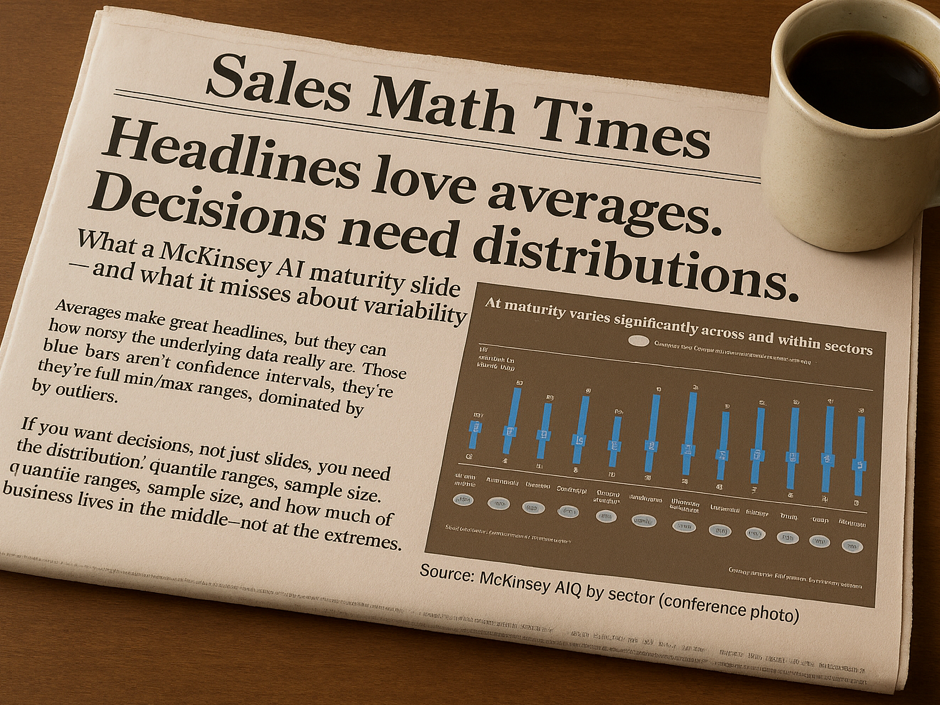Why Sales Forecast Accuracy is a Silly Goal
- Bill Kantor
- Sep 8
- 3 min read
Updated: Nov 13

Here's a great interview [1] with Rob Hyndman, one of the world’s leading authorities on forecasting. Rob defines forecasting as:
An estimate of the probability distribution of a variable to be observed in the future.
That’s worth pausing on.
Forecasting is not about accurately predicting a single number. It’s about understanding the probability distribution of possible outcomes.

Hyndman’s Conditions of Forecast-ability
Hyndman highlights five conditions that make something forecastable:
You understand the drivers of variation.
You have lots of data.
The forecast doesn’t affect the thing we’re forecasting.
The future is similar to the past.
There’s relatively little unexplainable variation.
Of Comets and Exchange Rates
Hyndman gives two examples:
Comets
If you want to forecast the path of a comet, you can tick every item: the drivers of motion are well understood, data are abundant, the comet won’t change course because you made a forecast, the past is a good guide, and there’s little randomness. Easy to forecast. For most purposes, there is not much need for a distribution.

Currency exchange rates
But try forecasting the USD to AUD exchange rate. You have a lot of data, but politics, human psychology, shifting global events—all come into play. And respected forecasters actually affect the rate. That fails on all but the second condition. Hard to forecast. Understanding the distribution is critical.

Are Sales Easy to Forecast?
Now, take Hyndman’s five conditions and hold them up against sales forecasting.
Do we understand all the drivers of variation in a sale? No.
Do we have lots of data? Usually.
Can forecasts affect sales? Yes! And this is your superpower.
Does the future always look like the past? No.
Is there relatively little unexplainable variation? No.
Noodle on that. Sales forecasting is a lot closer to predicting a currency exchange rate than it is to predicting a comet. It is possible to predict sales, but there are limits. And understanding the distribution is critical.
What Most Forecasting Processes Get Wrong
Most forecasting processes aim to give you:
A point forecast (e.g., “We’ll close $10.2M”).
Or a handful of points—hi, mid, lo.
But what do those points mean? What’s the probability of hitting the “mid”? How likely is it you’ll beat the “hi”? How much risk is there of falling below the “lo”?
Without those probabilities, those figures are context-free and effectively meaningless.
A Better Way Forward
Instead of focusing on accuracy, focus on realistic forecasts based on statistical methods:
Estimate the odds of exceeding any number.
That means you can ask: “What’s the probability we beat plan?” or “How likely are we to hit $12M?”
Don’t pretend forecasts are perfect. If your forecasts are grounded in classical statistical methods, they should be pretty good. But that’s not the point.

Sales has too many uncontrolled factors to make it consistently forecastable. So it's critical to understand the forecast distribution and the effects of changes in the factors you control.
Accurate sales forecasts are not the right objective for sales. A good forecast is the starting point for sales optimization. We use the forecast to increase sales by showing you where to focus, what risks to manage, and how to increase your odds of success. And success means that you've increased sales, which means that the forecast was wrong (because you did better). Consistently accurate forecasts = underperformance.
The Bottom Line
Sales forecasting doesn’t meet Hyndman’s criteria for easy forecasting. Distributions are critical to making sense of the forecast, and accuracy is a silly goal. Most important, because you have some control of the outcome, accuracy is not even a desirable goal.
Instead, the right goal is to answer this question: How can we use forecasts to inform corrective action and improve what is likely to happen?
That’s the difference between walls of numbers without context—and a forecast that actually helps you sell more.
[1] https://www.buzzsprout.com/1641538/episodes/7708129 This discussion starts at ~8:45.




Comments